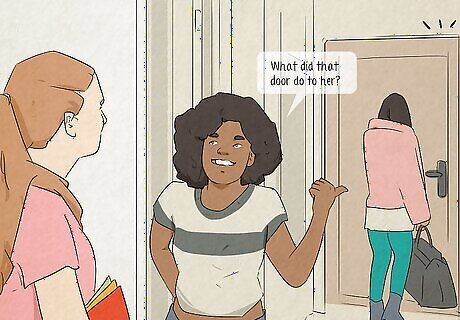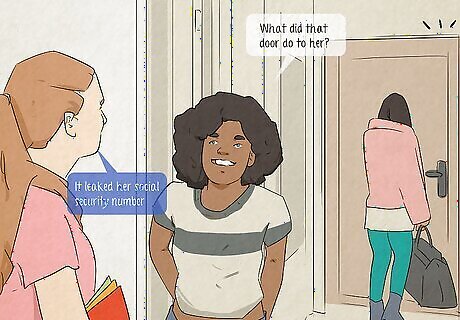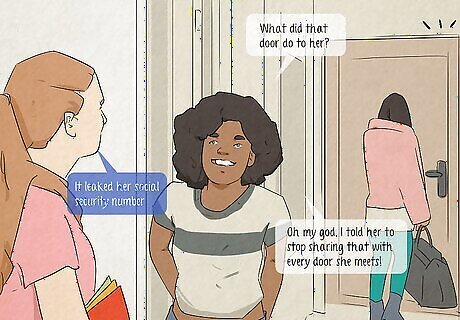
views
“Committing to the Bit” Meaning

“Committing to the bit” means to follow a joke or idea to its full conclusion. In most cases and conversations, this means batting a joke or funny concept back and forth with someone until you can’t escalate it anymore, no matter how crazy or unrealistic it is. This can look like a fast-paced and witty exchange between friends, an interesting comedic or theatrical performance idea, or a recurring joke that gets repeated over a long period of time. Example: You and a friend have a wild idea to behave like robots when you show up to a party later tonight. You move in jerky motions, talk in monotone voices, and keep leaving the room to “recharge.” When you talk to each other, you keep inventing new facts, abilities, and backstories for your robot characters. It’s incredibly stupid, but you’re taking the joke to heart. You: “Beep boop, nice to scan your human face again, Sharon.”Sharon: “You’re really committing to this robot bit, aren’t you?

It can also mean doing something ironically until it becomes real fun. Among Gen Z and Millennials, it’s common to do something stereotypically “lame” or “cringey” with lots of enthusiasm and hype. This seems odd, but by going all in on the absurdity or dorkiness of something, it becomes genuinely enjoyable. In this sense, “committing to the bit” is a way to let loose, do something different, and poke gentle fun at something you wouldn’t normally interact with. Example: Say there’s a monster truck rally happening near your town. You and your friends have never been to one in your lives, but decide to buy tickets for the heck of it. You buy monster truck t-shirts, novelty glasses, and pick a truck to root for. When you get there, you cheer and scream like you’ve been a lifelong fan. It ends up being super fun because you “committed to the bit” and leaned into the enthusiasm of an event you might not have otherwise gone to. You: “We went IN on that monster truck rally last night. It was actually a lot of fun!”Them: “Wow, you really committed to the bit, huh?”
What is a bit?

A bit is a string of related jokes with a funny take on a simple idea or fact. Think of it as a creative spin on a small slice of life that gets blown out of proportion into an absurd, humorous joke or concept. Say a friend is complaining about how heavy their luggage is. The inconvenience of heavy luggage is a simple thing we can all relate to, and it becomes hilarious when the stakes of the situation or the source of the weight are exaggerated: Friend: “Ugh, my suitcase is so heavy!”You: “Well that’s what you get when you pack 82 pairs of underwear for a 2-night stay.”Friend: “It’s not all underwear! I have to pack all my jewels too in case I have to barter for more.”You: “Ah yes, your spare underwear jewels. Can’t travel anywhere without ‘em!” In this example, the “bit” is the running joke that your friend has to pack excessive underwear and jewels to use as currency in case they run out. This is an unrealistic idea, but one that was born from the very real scenario of carrying heavy luggage.

Famous example: “Who’s on first?” In this legendary scene performed by Abbott and Costello, two friends confuse each other when they try to explain which baseball player is on first base. The baseball player’s name is Who, so when one asks, “Who’s on first?” the answer is, “Who.” This small idea—that a player’s name is Who—is the start of the bit. The comedic back-and-forth that follows is the escalation that turns this idea into a bit: Abbott: “Who is on first.”Costello: “That’s what I want to know, who’s on first?”Abbott: “Who is on first!”Costello: “I’m asking you! Who’s on first?”Abbott: “Yes.” In comedy, a bit is longer than a single joke, but not so long that it makes up an entire set or performance (although, committing to a single idea like “Who’s on first?” for a whole 10-minute set could be considered “committing to the bit” in its own right!). Bits can be performed by solo comedians (like in stand-up comedy) or by duos or groups through witty dialogue.
Types of Bits & Examples

Dialogue bits Most often, a bit springs up spontaneously between two people. These kinds of dialogue bits are usually fast-paced, witty, and almost like a game. They use an absurd statement, a misspeak, a random idea, or something that just happened in your surroundings as the genesis for a crazy back-and-forth (you probably do this all the time with your friends without knowing. If you hang out with comedians or actors a lot, then you’ve definitely witnessed a few bits). For example: Person A: “Man it’s hot out.”Person B: “Yeah. Thankfully I removed all my sweat glands.”Person A: “Oh, you went to that good doctor in Miami?”Person B: “Yup! I haven’t sweated a day since! I feel very unwell, though.”

Repetitive physical bits Not all bits need dialogue, or even words at all. You can use your facial expressions, body language, or physicality to make a joke. For example, instead of calling your girlfriend “My Queen,” you could just bow to her whenever she enters a room. If you do this once, it’s a fun joke. If you repeat it, it becomes a bit that you’re committing to. Sometimes, a repetitive bit can become a non-joke. If you continuously bow to your girlfriend, it might become more of a habit than an actual joke down the road (which is also funny in itself).
How to Start Doing a Bit with Someone

Choose an absurd idea or statement to start riffing on. Try to pick something that’s loosely based on reality or related to something that just happened. For example, maybe someone slammed a door extra loud. You could react and say something like, “What did that door do to her?” This statement is based on a real thing (a door slamming), but there’s absurd and comedic potential in the idea that the door is sentient and did something to irritate the person. You could start with a funny sounding word, a comment on something someone just said, a mispronunciation or misunderstanding, or anything that makes a comedic light bulb go off in your head. The best bits start spontaneously without a clear end goal in mind, so don’t stress about finding the “right” thing to say. “Committing to the bit” means you’re going to run with this idea no matter what, so go for it and have fun!

Listen closely to the response your statement gets. If someone wants to join in on your bit, they’ll probably reply with another line or idea that heightens or extends your original joke. If you ask, “What did that door do to her?” then you might get a silly response like “It leaked her social security number.” Listen carefully to what the other person says for inspiration for your next line. If they say “It leaked her social security number,” you could say something next about how the door is untrustworthy or wonder how it gathered such private information in the first place.

Reply with something that continues to build on the original idea. Your bit partner has set you up with some new details, so continue riffing. Ask yourself, “If what that person just said is true, what else could be true in this world we’re building?” This is very much like the “yes, and” idea when doing improv comedy; nothing anyone says is “wrong,” so accept it as fact and add something to it. You: “What did that door do to her?”Them: “It leaked her social security number.”You: “Oh my god, I told her to stop sharing that with every door she meets!”

Extrapolate until someone breaks or the joke runs out of steam. Keep batting the idea back and forth until the joke reaches a natural conclusion. This could be until someone runs out of ideas, gets distracted, or just starts laughing so much they can’t go on. You: “What did that door do to her?”Them: “It leaked her social security number.”You: “Oh my god, I told her to stop sharing that with every door she meets!”Them: “This is just like that time the sliding door at the lake house stole her identity.”You: “She really needs to get a handle on this.” What started out as a quip about a loud door slam turned into a back-and-forth bit about a friend who keeps getting her identity stolen by unfriendly doors. It makes no sense, but the commitment makes it funny!

Call back to the bit later as an inside joke. The next time your friend slams a door, you might say “Oh, I guess she got her identity stolen again!” Anyone that heard the original bit will get a kick out of hearing this absurdity again, and continuing to reference it into the future is another way of committing to the bit, too.




















Comments
0 comment